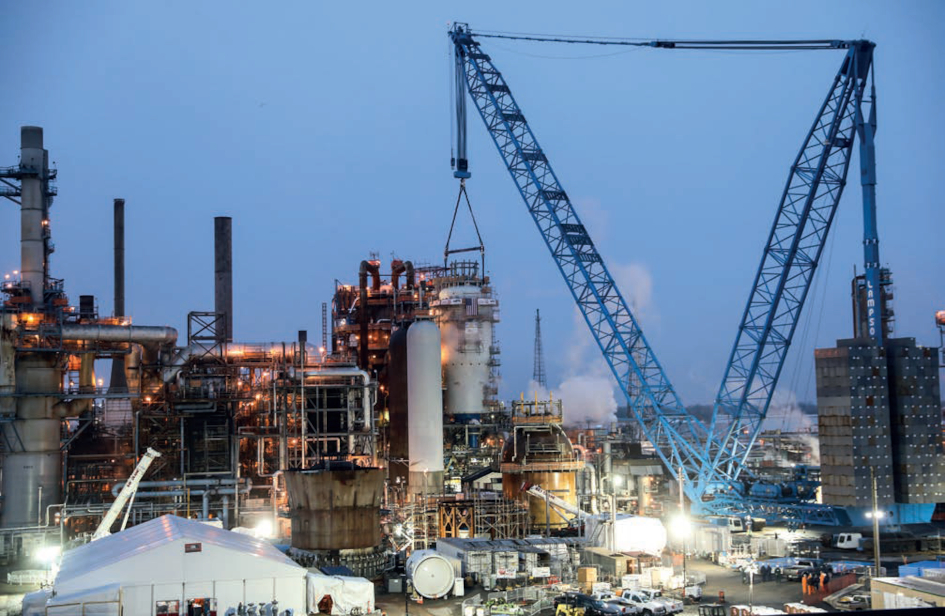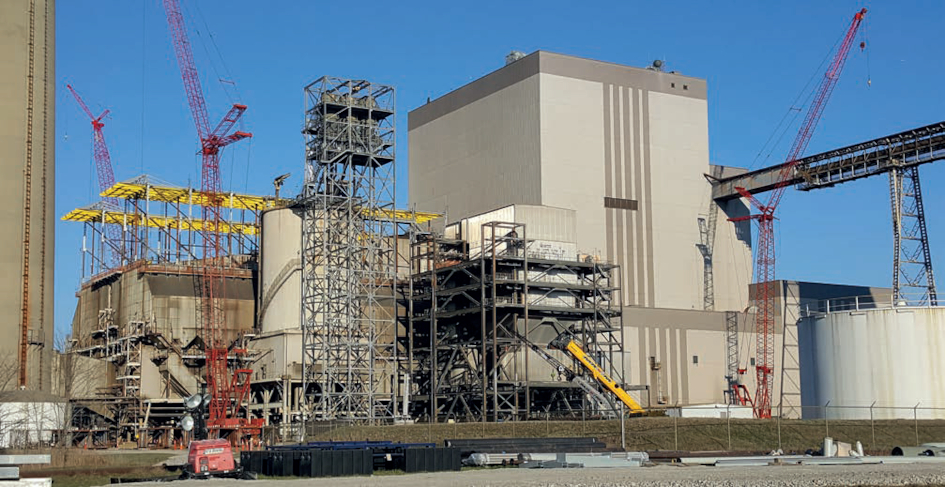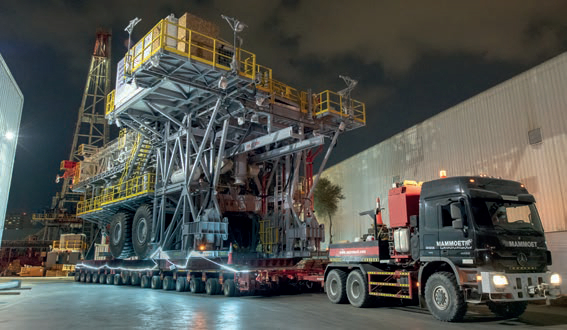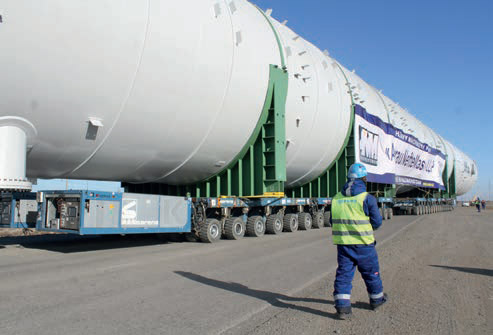A Challenging Market
20 May 2021Julian Champkin speaks to heavy lifting and special transport companies about the demand from the onshore oil and gas industry over the past year, the future market as well as the challenges associated with serving this sector.
Heavy loads, constricted sites and short time frames are challenges lifting companies often have to face when serving the onshore oil and gas industry. Transportation of large components and prefabricated modules for this industry can also be difficult, especially when narrow streets and tight curves have to be negotiated. And onshore projects are just as vulnerable as offshore ones to global pandemics and the price of oil – which has been low since the pandemic started.
Gert Hendrickx, projects sales director at Sarens, says: “The combination of the Covid-19 pandemic and the substantially dropped oil prices has definitely had an impact on decision makers globally. We have seen planned investments not only postponed but also completely cancelled.
“The big oil companies became very reluctant not only on new green field investments but even on smaller extensions in existing plants. Only necessary maintenance works and adjustments that have to be made due to local legislation— environment related for example— will continue. Some smaller new units were built, but those are quite exceptional.”
“Whatever the cause, there was a fall in new construction at LNG facilities,” says Rick Bohne, Jr, director of sales and marketing for Mammoet USA. “These large projects call for a great deal of lifting and transport, so our workload was lower than was anticipated as we entered 2020. The lack of demand for oil, gas and chemicals also slowed the refining process at existing facilities.
We saw several facilities reduce production and push planned operating and expenditure projects by at least twelve months.” It is not all gloom: “As the months have gone by and the market has had time to process the impact, we are seeing many of these push-backs reversed, by up to about six months.”
“The maintenance of existing refining capacity therefore becomes critically important.” Fortunately, he says, that work will still be there: “Ultimately, there will be a healthy amount of maintenance work needed in this space for the foreseeable future.”
Maxim Crane Works operates across the US in both transport and lifting. COO Frank Bardonaro notes the downturn but is already experiencing the up-tick in maintenance work that Bohne envisions: “Maxim is focused on down-stream oil and gas lifting related services. We have seen the largest impact of the slow-down hitting some of the companies who are more focused on the upstream production operations, and that does not seem to be improving.
“However, actual plant work and ‘inside the gate’ activity has seen a steady improvement over the past six months. Even though overall production and spending within the refinery segment has slowed, it is not something we haven’t seen before. Ultimately, our premier customers continue to invest in upgrades, safety, and general maintenance at levels that we had expected. While we are doing a significant amount of work on new projects from our partners, the majority of our focus remains normal maintenance, expansion, and upgrades within existing facilities.”
Bob Kelly, general manager of ALL Crane Rental of Pennsylvania, says: “There was a slowing down in oil and gas work in the last year, but I attribute it more to the pandemic than to price fluctuations. The work is starting to pick back up now, and has been for the past several months. We were down to nine drilling rigs in Pennsylvania and now we’re up to 23.”
“We have seen a significant slowing in the oil and gas industry due to the price of oil as well as the pandemic,” says Kate Lampson, director of marketing at Kennewick, Washington headquartered heavy lift and heavy haul construction corporation Lampson International. “In most cases, projects are being put on hold, though there have been a few cancellations.”
The contraction, she says, is worldwide: “From the US and Canada to Australia and Asia, oil and gas projects have been stalled or cancelled due to the pandemic. In addition to that, in certain countries some of these delays or cancellations can be attributed to politics and policies.” In the US it is exacerbated, she says, by the Biden drive for renewable energy sources: “We are also seeing a shift away from the oil and gas industry as a direct result of the new administration, and that is hurting the construction industry.”
Rudy Corbetta, marketing and communications manager of Italian special transport and heavy lifting specialists Fagioli agrees that the new normal will focus less on big capital. “Some of the projects planned for 2021 will be postponed due to pandemic situation but we do think that 2022-2023 will see the return of a 'normal’ situation, even though it seems that there will be a drop of investment over the next years,” he says. “Nevertheless, there are still big projects; and Fagioli have encountered them in all parts of the world.”
“Fagioli recently won three important contracts in the oil and gas sector for a total value of over €80m,” he says. “Projects will be carried out on three different continents, Africa, Asia and North America. The most relevant concerns forwarding operations, heavy transport and lifting of modules and vessels for a huge LNG [liquified natural gas] plant in East Africa. The second is for the lifting of seven reactors, each weighing 2,000t, for major modernization of a refinery in Thailand. The third concerns handling and installation of process modules in Louisiana for a new methane gas liquefaction plant, one of the largest in the Gulf of Mexico.”
CHALLENGES
These are not small projects, either in value or in size; and they present the challenges typical to all such projects.
“The challenges don’t change: they have been the same forever,” says Maxim’s Bardonaro. “The primary focus is always safety. These customers are working within some of the most challenging environments that exist. We obviously face the challenges of lift capacity, large operating crews, and tight deadlines, but none of that comes before developing and executing a safe operating plan. Fortunately, the customer and the industry are aligned on these matters.”
“In our larger projects for the oil and gas industry the main challenges are the space limitations,” says Corbetta. “You are working within sites where other activities are performed at the same time. Schedules are always tight and items are not easy to handle. In confined spaces you need to find the most suitable equipment and solution, which means that in some cases you need deep engineering studies to safely execute the job. “
“Capacity, space limitations, tight deadlines - the main challenges in refinery lifting work are all of those, although capacity is probably the Number One,” says ALL Crane Rental’s Bob Kelly. “Sizes have increased tremendously, especially here in the northeast. That’s because it’s often less expensive for plant owners to have assembly performed elsewhere then ship the completed components here by barge.
“As a result, when the time comes to install the new pieces on the job site, we must be ready with higher-capacity lift equipment that can accommodate greater weights. The trend toward higher-capacity cranes is something we’ve seen throughout the crane industry, driven by customer demand. That’s why it’s built into our business to always be updating our fleet to maximize load charts and give our customers the most modern options to work with.”
EQUIPMENT
“In general, crawlers and rough terrain cranes do the majority of work in the oil and gas sector,” Kelly continues. “We’ve invested in dozens of new units in the past 18 to 24 months from Liebherr and Manitowoc to help provide wide capacity options. The Manitowoc 2250 crawler gets a lot of work in this market. It has the load charts that are the best fit for many of the lifts called for in oil and gas. With its 300USt capacity and 300ft boom it gives customers flexibility in reach and weight.”
“For lifting, equipment needs to be large,” says Corbetta of Fagioli. “We have been using the greatest crawler cranes available, with capacities up to 1,350t. And we have just bought the biggest standard crawler crane on the market, of 3,000t capacity, which we shall be using on projects in the APAC region. Non-standard lifting equipment can be needed as well: we have one of the largest fleets of strand jacking and tower lift systems.”
Sometimes, though, still further ingenuity is required. At their Thailand refinery project the installations will be performed by a system of powerful “translating” lifting towers, completely designed and built by the Fagioli engineering department, which are so new, and so innovative, that they will say no more about them at present.
“When working in refineries we perform the vast majority of the lifts with our Lampson Transi-Lift,” says Kate Lampson. “What sets it apart is its ability to fit into small footprints on work sites, its capacity at radius and its ability to pick, carry and swing simultaneously. It is easily transportable to anywhere in the world and can be constructed in just 21 days. That makes it well suited for all types of power plant construction and work at refineries. With its reachability and its lift radius the Transi-Lift is able to reach out over obstacles like overhead pipe racks and duct work, pick up the load and deliver it to its new location without issue. And its ability to manoeuvre in small spaces lets us work in tight areas, thereby giving us an advantage.”
“Some of the refineries we support have been in operation for many decades,” says Bohne of Mammoet. “They were not necessarily built with the spacing required for the modern-day turnaround scope in mind. This is why the Logistics Coordinator on any turnaround needs to be your best friend. Real estate is at a premium. But large components will still need to be swapped and we are seeing projects for modernization or expansion to existing units.
"These lifts can be highly complex, and are driving innovation within the industry. For example Mammoet has the new Focus30, which has been designed to help refineries to modernize within the same footprint. Its boom mast is assembled vertically in sections, which means it can be assembled from just a 30x40m footprint.
“It can be assembled within 10 to 14 days; and boom erection does not overhang adjacent areas of the plant, so plant workers, pipe racks and other key infrastructure can operate more safely. The Focus30 is a 2,500t class crane, and so is ideal for a wide range of lifts, and its low ground bearing pressure means it can operate at a wider range of sites.
“The drivers for crane capacities on such jobs are twofold,” he says. “On one hand, plants may want to increase their output and will need to install larger and therefore heavier equipment; on the other, spacing limitations are such that our cranes need to sit further away from the equipment being replaced. Either way, a larger crane is needed.” Nor does it end there: “Regardless of which necessity drove the initial push to design and make everlarger cranes, the existence of these high-capacity cranes also allows plants to think differently about their work - which makes the cycle continue.”
TRANSPORTATION
Before components can be lifted into place, they need to be transported to the site. Their transportation can be very complex, to the extent that our experts find it tough to single out specific challenges.
“In special transport what are the challenges? Honestly, there are too many variables to list,” says Bohne of Mammoet. “We move heavy objects from here to there and the perspective we try to adopt is that of our clients. It is not our transport equipment they are buying; it is what they are enabled to do by having this heavy thing moved from here to there. When we process it in that context, we are much more likely to overcome the latent challenges that are unique to each project.
“The challenges are not specific to the act of transport; that is just one component. In truth the complexity is compounded by the circumstances of the client and the surrounding area. Our expertise may be in heavy transport but the real manifestation of our experience is in executing simple acts in complex environments.”
And moves continue to get larger and heavier. “Absolutely” he says. “Modularization continues to be a preferred method of construction for so many of our clients. This means bigger, heavier objects need to be transported globally to a site, and, that logistical endeavor aside, getting from the ship to the site poses many unique challenges that drive innovation. For example, we have been fortunate to design and execute of number of levee crossings that were required for the equipment to access the site. Of late, we have seen requests to transport modules of ever increasing size.”
With which Corbetta of Fagioli agrees: “For heavy transport activities there are more variables to be considered. You have to start from Point A and end at point B but the distance is not the main problem. There are authorizations and permits, there are bridges and highways—are those bridges strong enough and the highways wide enough?—there are historical cities to traverse. It is an altogether more complicated matter. “And there has been a definite increase in the dimensions of items to be moved. Modules and components have seen a dramatic increase in size. Clients are coming back with complex requests, which require a complete ‘tabula rasa’ approach compared to the past. It has been necessary to invest in engineering, in up-to-date equipment and in personnel to follow these new requirements of the market. Bigger modules to be handled, challenging projects, and improved health and safety and sustainability philosophies are all part of it. The competition has become ever more noticeable both in the traditional transport sector and in more specialized forms of transport.”
“As ever, we have to supply the highest quality of work together with the highest standard of equipment at the cheapest price. More than ever we are being pressured by our customers to work towards a price level that will become unsustainable in the long term,” says Hendrickx of Sarens. “But apart from the commercial challenges, the evolution to keep doing bigger and heavier does not change: maybe it is currently a little slower than before, but that evolution remains.
“The increase in size of the components to be moved is part of the eternal duality and is also the connection between the load to be lifted and the equipment with which we lift or move it. There is that constant feedback between load and equipment that enables the market to hoist and/ or drive ever larger and heavier components. Take the example of SPMTs: Twenty years ago they were of 25t capacity; now 48t and more is common.”
It is no easier in the USA, says Lampson: “Some of the challenges that we face are restrictions from local municipalities, state and federal regulations as well as regulations on-site, road conditions, unexpected weather delays, schedule changes and environmental impacts. There is always an increase in the size of components, and demand for larger components is ongoing. You see this in the increased size of cranes that manufacturers continue to produce each year, and in the demand for those cranes. As with the crane manufacturers, the heavy transport manufacturers are constantly designing their equipment to haul larger and heavier components.”
Lampson International has large fleet of self-propelled crawler transporters, ranging in size from 600USt per unit up to as much as 4,000USt per unit and can ascend grades of up to 10%. “In addition, we own approximately 350 lines of self-propelled rubber-tyred transport trailers, including Goldhofer, Nicholas, Commetto and Scheuerle. All these machines are used throughout the petrochemical and refinery industries conveying vessels and large modular constructed process equipment of all types,” says Lampson.
“We are seeing some great new heavy-transport products being developed by the manufacturers” says Bardonaro of Maxim; “and we will acquire that equipment which is best suited for our current customer demand.”
And the future? “Obviously, we are all looking at the current shift to renewable and clean energy,” he says. “That will definitely have an impact on where this segment goes over the next 20 years. However, we believe that these industry leaders are not sitting back and hoping for a reversion back to 100% dependency on oil and gas. They are doing the research and development needed to shift their investments into projects that will continue to utilize the crane and lifting industry. Therefore, although there may be a reduction in the number of new refinery specific projects, these same customers will continue to consolidate, improve and invest in activity that propels future growth.”
He is not alone in that opinion. “Taking into account what we are seeing now and the shift to more and more green-oriented supply of raw materials and energy, I have to say, with caution, that oil and gas is rather a shrinking business,” says Hendrickx. “Of course it is compensated by alternative segments like offshore wind, and more environmentally friendly technologies and processes”
In the short term, though, the era of fossil fuels is not yet over. “I think the sector will hold its own at least during the Covid recovery,” says Kelly. “Oil and gas is expanding in Texas. Here in Pennsylvania, we’re getting more gas out of the ground than ever before. A predictable longer-term decline in petroleum demand could have the next decade looking very different, but right now, as always, the energy business is about staying nimble. Our branch has handled roughly 80% of the wind energy work that’s come through the state, but it still doesn’t compare to more traditional fossil fuels that feed power plants.”
“There will continue to be a need for heavy equipment to be lifted and transported in this sector,” says Bohne of Mammoet. “There are certainly other sectors emerging or growing that will require more lifting and transport than before, but the oil and gas sector will continue to have needs.”
 In West Virginia, ALL Crane & Equipment Rental has been reconstructing a methanol plant that has been transported from Brazil. It was the first use of the company’s newly-acquired Liebherr LTM 1750-9.1, the second in its fleet. The nine-axle all terrain crane was used to lift an 83USt compressor for the methanol plant
In West Virginia, ALL Crane & Equipment Rental has been reconstructing a methanol plant that has been transported from Brazil. It was the first use of the company’s newly-acquired Liebherr LTM 1750-9.1, the second in its fleet. The nine-axle all terrain crane was used to lift an 83USt compressor for the methanol plant
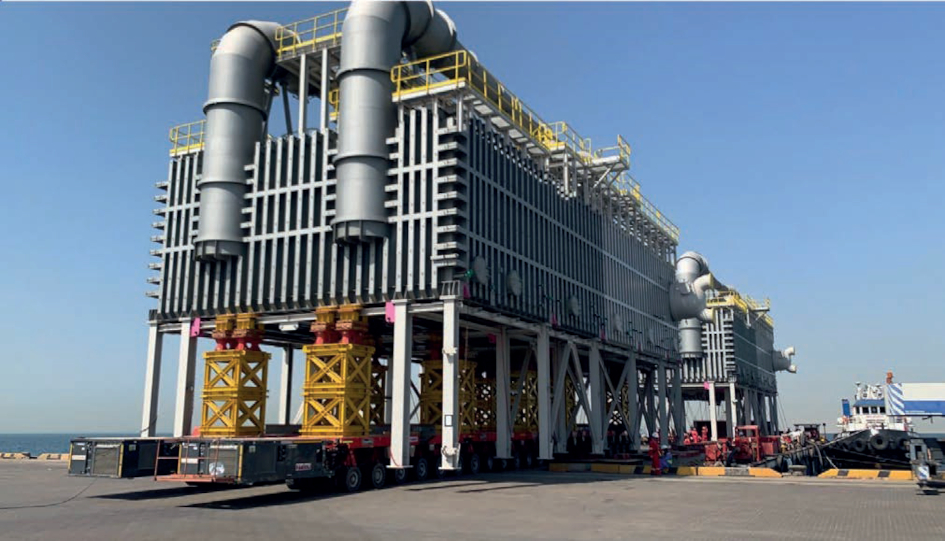 Fagioli transports a module for the Bapco Modernization Programme (BMP). The project is located on Kingdom of Bahrain’s Eastern coast and entails the expansion of the capacity of the existing Oil Refinery. Fagioli says the two-year project is one of the biggest operations ever executed by the company in the Middle East.
Fagioli transports a module for the Bapco Modernization Programme (BMP). The project is located on Kingdom of Bahrain’s Eastern coast and entails the expansion of the capacity of the existing Oil Refinery. Fagioli says the two-year project is one of the biggest operations ever executed by the company in the Middle East.
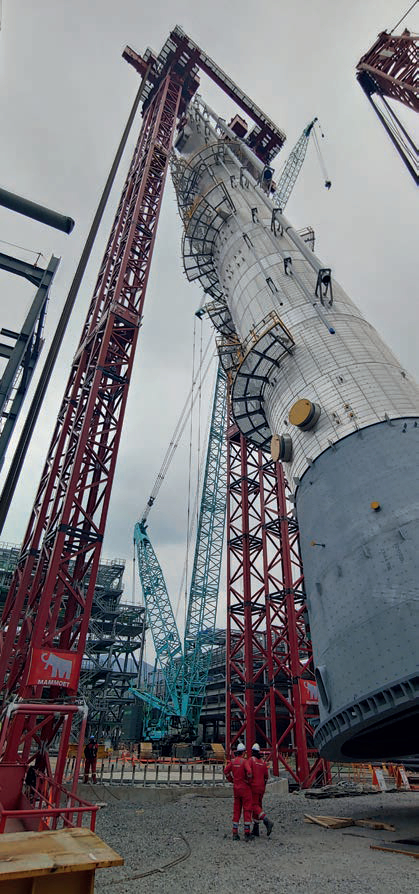 Mammoet has installed a C3 splitter, with dimensions of 113.94m x 7.5m x 7.5m and total weight of 1,840t, for the GS Caltex MFC (Mixed Feed Cracker) project in Yeosu, South Korea. This column was installed using Mammoet’s specially designed Hammerhead gantry system about 100m high. Container size compact mast sections (2.5m x 2.4m) were used to build the gantry and lifting was successfully executed by with four sets of 900t capacity strand jacks. Same number of strand jacks tensioned the tie back wires while a Manitowoc M18000 with 21000 MAX-ER was used as tail crane, supplied by Daeah E&C.
Mammoet has installed a C3 splitter, with dimensions of 113.94m x 7.5m x 7.5m and total weight of 1,840t, for the GS Caltex MFC (Mixed Feed Cracker) project in Yeosu, South Korea. This column was installed using Mammoet’s specially designed Hammerhead gantry system about 100m high. Container size compact mast sections (2.5m x 2.4m) were used to build the gantry and lifting was successfully executed by with four sets of 900t capacity strand jacks. Same number of strand jacks tensioned the tie back wires while a Manitowoc M18000 with 21000 MAX-ER was used as tail crane, supplied by Daeah E&C.
